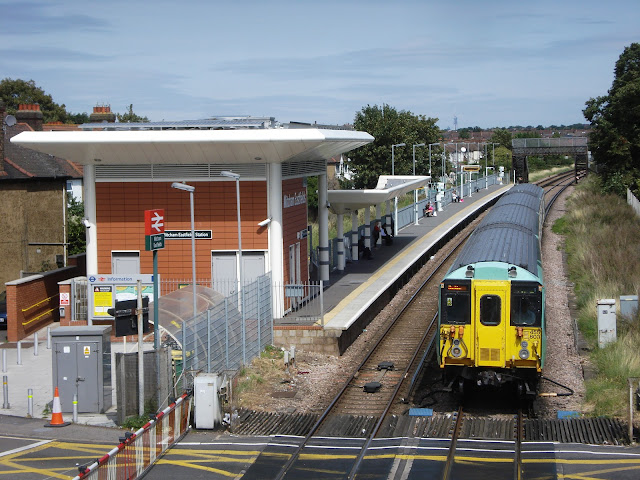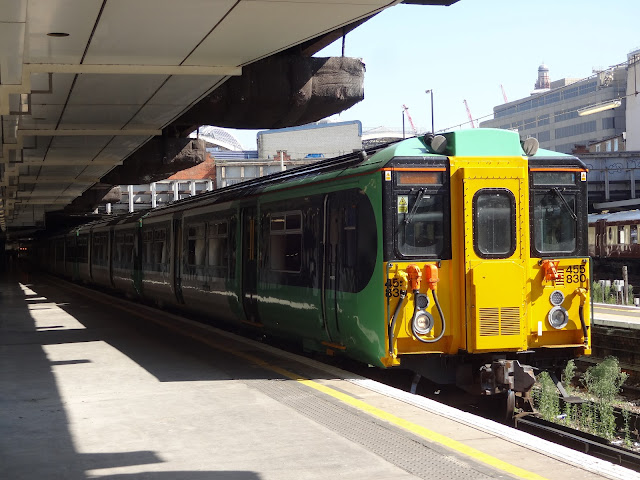 |
| Through Mitcham Eastfields on a Horsham train, 10 August 2011 |
This coming Saturday, 14th May, sees the withdrawal from the suburban routes of the South Central Division — the tangle of railways running out of Victoria and London Bridge into south London — of the class 455 electric multiple units that have held sway in these parts for nearly forty years. Their siblings on the South Western lines out of Waterloo will apparently follow in the next few months.
 |
| Basking in the sun at Victoria, 28 August 2013 |
Few ordinary passengers are likely to mourn them. They are not glamorous, nor were they built to be, though I think better care could still have been taken of their interiors in recent years. They were designed for mass short-distance transport, to lug commuters around the Hills and Commons of the southern boroughs; to venture to climes no more exotic than Crystal Palace, Epsom Downs, Caterham or Dorking. I doubt they have averaged more than around twenty miles per hour over the course of their working lives. But they have worked solidly, clocking up thousands upon thousands of rush-hours since the early 1980s.
.JPG) |
| Rumbling across the South Circular overbridge into Tulse Hill, bound for the Wimbledon loop, 11 April 2019 |
I am among those who will miss them. It was against the backdrop of these faithful workhorses, plying their way up to London or down to Dorking, their acceleration distantly, enticingly audible over the suburban rooftops, that my rail enthusiasm was first contracted and swiftly found to be incurable. The aforementioned South Western sister-class ran right past my grandmother’s garden, and I used a 455 as my subject for the centre-piece of a school art project (because I knew I could draw trains and buildings, but not people!). More recently — until the pandemic in fact — my train into work was reliably formed by one of these units.
 |
| A Victoria-bound semi-fast accelerating through Mitcham Eastfields, 4 January 2011 |
Like the slightly younger 319s (themselves a familiar sight around South London until a few years ago) and their cousins the recently-scrapped two-car 456s, the 455s were built at York by British Rail Engineering Limited, as lettering on the step-plates proudly declared. However, in contrast to the 319s — which were more souped-up trains, designed for Luton and Gatwick routes, for people with flights to catch, always seeming cramped by the chords and spurs of suburban south London, itching for the open stretches of the Brighton or Midland main lines — the 455s seemed gentler and more sedate, more suited to the way we do things here, south of the river, in the land of the electrified third rail. To a 455, with its seldom-attained top speed of 75 mph, it did not seem to matter if we got to Ewell East now or some time next week. They trundled their way around, taking their time about everything. No point rushing this curve or that junction; there’ll only be something else to brake for around the next bend.
 |
| Through the window onto dawn-lit commuterland, 1 October 2018 |
Adding to the dreamy aura of these trains were the various reassuring sounds they made: the chirruping of the brakes and the soft sigh on their release, the warble-piping of the original door alarms, the clunk of the camshaft on departure, and the leisurely thrumming of the brake compressors, this last being the sound I will miss the most. Then there were the motors, matching the register of a cello, rising from a growl from a standstill to the very top of the tenor range if given the chance to stretch their legs. The only alarming sound was the occasional crunch of electricity arcing from the third rail.
 |
| Arriving at Streatham Hill on the 1617 to London Bridge, the once-daily parliamentary service via the Leigham Spur and Tulse Hill, 25 April 2019 |
The motors themselves are worth remarking on, for they are actually recycled. Incredible as it may sound, they are over eighty years old, and more than twice the age the trains they have been powering. The early Eighties, when these units were built, were not an easy time for British Rail, which, struggling under persistent inadequacies in government subsidy, had constantly to make do and mend with their scarce resources. Their solution in this case was to fit the new trains with not only second- but third-hand motors built originally by the Southern Railway for its electric units in the 1930s. Though now into their ninth decade and effectively dating from the electrification itself, the motors still seem perfectly sound to my ear. Whatever the reason is for the withdrawal of these trains, I doubt it has anything to do with the traction equipment.
 |
| A down train draws into Wandsworth Common, 9 December 2018 |
I am not the only one sad to see them go. ‘South London is [going to] feel weird without them,’ said one contributor to the ever-perusable Rail Forums. Another chap, a driver who also films the modern railway scene and has a presence on YouTube, told me in an exchange in the comments, ‘These were the trains I grew up on, the trains that took me on all sorts of adventures and when I passed out [i.e. qualified] as a driver became my core traction.’
%20-%20Copy.JPG) |
| Epsom train rounding the curve south of Mitcham Junction, 4 February 2022 |
There is always a pang to see the clearing out of the furniture of our beginnings, however ordinary these things may be. Perhaps, in fact, the more ordinary and the more constant they have seemed, the sharper the pang. Bit by bit, the railscape of my childhood is disappearing (the analogue signals, the bell at Eastfields level crossing, the late Phil Sayer’s voice over the speakers…), and by the end of this weekend another major part of it will have crumbled completely away. I will certainly miss the familiar presence of these old units, with the many associations they hold for me.
.JPG) |
| A final farewell, Mitcham Common, 4 February 2022 |
But let us end with the nearest a 455 ever came to attaining railway glory. Under the pre-2018 timetable, one single passenger service each weekday was booked to run non-stop down the fourteen-mile line from Dorking to Horsham, and this was generally allocated to a 455 unit. So, just before that timetable was abolished, I took one of the last opportunities to experience this run, and filmed the journey from just beyond Betchworth Tunnel to just short of Horsham. As I have said, 455s hardly ever had the chance of a clear non-stop flat-out run like this, and certainly in their latter years Horsham was the furthest south they ever ventured in regular service. So it was a rare treat to see this humble suburban unit reliving the glory days of the old Bognor expresses, accelerating to the full line speed of 75 mph along probably my favourite stretch of railway in south-east England. (We really begin to pick up speed after Holmwood, five minutes in, and after Ockley, at six minutes, there is the added bonus of some jointed track, which we hammer over at full tilt.) The date was the 14th May, 2018 — four years to the day, as it turns out, before the final withdrawal of the class.

I love this post, especially the description of the outgoing train's sounds. Train enthusiasts (is trainspotter politically incorrect, or just inaccurate?) seem to prefer slow trains to fast ones!
ReplyDeleteThank you! I'm always glad to know my railway posts also appeal to ordinary readers. (Though I would probably not be able to resist writing them even if they didn't!)
Delete'Rail enthusiast' is how I'd describe myself, as I'm hopelessly interested in everything to do with railways, even if there don't happen to be any trains around. I wouldn't call myself a 'trainspotter', as I'm not so interested in spotting trains / collecting numbers, etc., but there are plenty of enthusiasts have no problem with the term — including the young generation now in their teens. There's plenty of footage on YouTube of a special farewell tour which ran on Saturday. It seems to have made its final departure from Victoria amid something of a carnival atmosphere, with young enthusiasts out in force.
That's a very interesting point about slow trains as opposed to fast. You may be right. A lot of modern trains seem just a little too sleek, making just a little too light work of everything. Perhaps it's easier for slow trains like the 455s to develop a certain character.
'Train enthusiasts' or 'rail enthusiasts' is probably the better term, though.
Delete